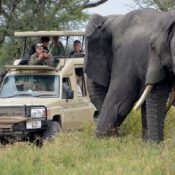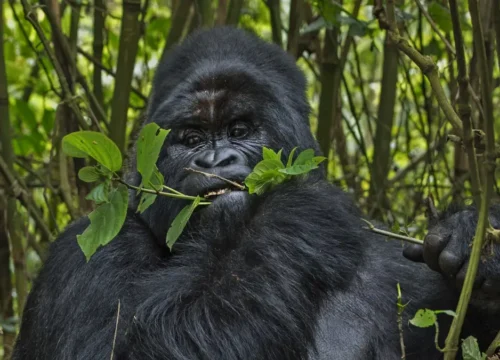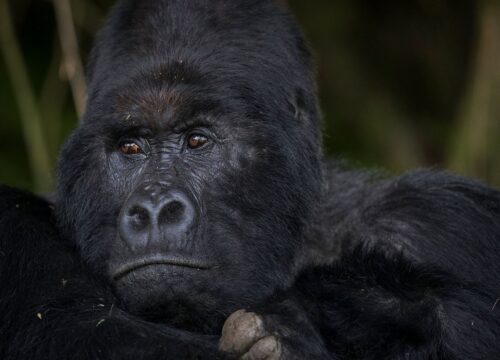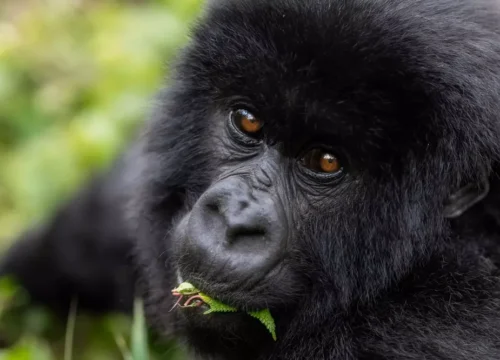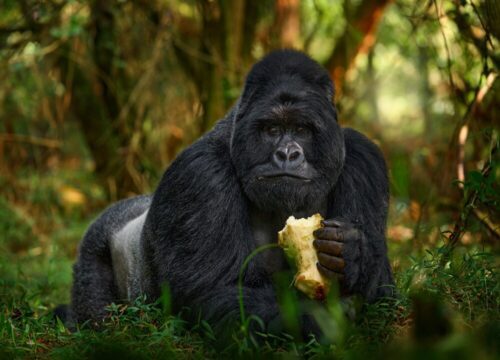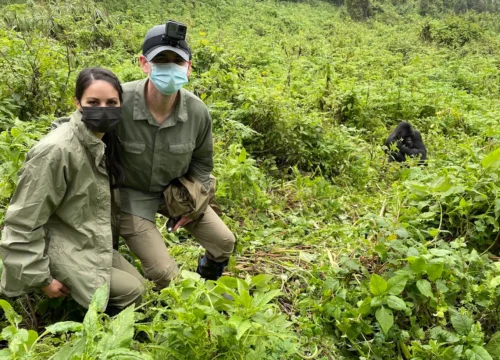Murchison Falls National Park: The Ultimate Safari Destination in Uganda

Murchison Falls National Park is not only Uganda’s largest and oldest protected area, but also one of Africa’s most spectacular natural destinations. Known for the explosive power of the Nile River as it squeezes through a 7-meter gorge and plunges 43 meters below, Murchison Falls offers an unforgettable experience of raw beauty, untamed wildlife, and extraordinary landscapes. It’s a place where safaris come alive not just with lions, elephants, and hippos but with the thunderous roar of one of the world’s most powerful waterfalls echoing across the savannah.

Nestled in the northwestern corner of Uganda and spanning over 3,840 square kilometers, Murchison Falls National Park lies within the greater Murchison Falls Conservation Area (MFCA), which also includes Karuma and Bugungu wildlife reserves. The park is bisected by the mighty Nile River, which creates a rich mosaic of habitats ranging from open savannahs and woodlands to riverine forests and swampy wetlands. This ecosystem supports over 76 mammal species and more than 450 bird species, making it a premier destination for both game viewing and birdwatching.
Best Murchison Falls Safaris/Tours/Packages
3 Days Murchison Falls Safari in Uganda – Wildlife, Nile Boat Cruise & Top of the Falls Hike Available for booking in 2025, 2026, 2027 and 2026
4 Days Murchison Falls Safari Uganda – The Best Game Drives, Boat Cruise and Top of the Falls-Available for booking in 2025, 2026, 2027 and 2026
Travelers visiting Murchison Falls National Park are often drawn by the promise of witnessing the dramatic waterfall up close, but the real magic lies in the diversity of experiences. From sunrise game drives through the Borassus palm-studded plains, to tranquil boat cruises along the Nile that bring you face-to-face with crocodiles, elephants, and hundreds of hippos, the park offers a safari adventure that is as dynamic as the landscape itself. Add chimpanzee tracking in Budongo Forest and community encounters with the Alur and Acholi cultures, and the park becomes more than just a wildlife destination—it becomes a cultural and ecological journey through Uganda’s northern wilderness.
Unlike many other famous African parks, Murchison Falls National Park remains less commercialized, which allows travelers to enjoy a more authentic and intimate safari experience. Whether you are a photographer seeking to capture the perfect shot of a giraffe against a flaming orange sunrise, a birder searching for the elusive shoebill stork, or a family on your first safari adventure, Murchison Falls offers a unique blend of excitement and tranquility.
Murchison Falls National Park continues to be one of the most visited safari parks in Uganda, and with good reason. Its accessibility from Kampala or Entebbe, the range of accommodation options from budget camps to luxury river lodges, and the year-round game viewing opportunities make it a must-visit on any Uganda safari itinerary.
In the sections that follow, we’ll dive deeper into the park’s location, wildlife, history, best travel seasons, safari activities, and the insider tips you won’t find on generic travel guides or Wikipedia. Whether you’re planning a short safari, a long adventure, or simply looking to learn more about this remarkable place, this guide will take you through everything you need to know about Murchison Falls National Park in 2025 and beyond.
Where Is Murchison Falls National Park Located? Geography, Districts & Ecosystem
Murchison Falls National Park is located in northwestern Uganda, covering parts of four districts: Masindi, Kiryandongo, Nwoya, and Buliisa. The park lies approximately 305 kilometers (190 miles) from Kampala, Uganda’s capital city, making it accessible for both short and extended safaris. Whether you’re arriving by road or air, Murchison Falls National Park is well-connected to the country’s major tourism circuits and is often combined with other top destinations like Ziwa Rhino Sanctuary, Kibale National Park, and Queen Elizabeth National Park.
Geographically, Murchison Falls is part of the Albertine Rift Valley, a region known for its extraordinary biodiversity and geological features. The park stretches from the Karuma Falls in the east to the Albert Delta in the west, where the Nile River empties into Lake Albert. This vast conservation area, covering over 3,840 square kilometers, is part of the greater Murchison Falls Conservation Area (MFCA), which also includes Bugungu and Karuma Wildlife Reserves, expanding the total protected area to about 5,000 square kilometers.
The landscape of Murchison Falls National Park is one of the most diverse in East Africa. The northern sector is characterized by savannah grasslands, Borassus palm trees, and acacia woodlands, offering excellent game viewing opportunities. The southern section, in contrast, features dense forests, riverine vegetation, and wooded hills, providing a haven for primates and rare birds. The iconic Nile River cuts through the heart of the park, flowing east to west and creating the dramatic Murchison Falls, where the river plunges through a narrow rock cleft only 7 meters wide before tumbling 43 meters below into the Devil’s Cauldron.
This unique setting creates an exceptional ecosystem that supports a rich variety of plant and animal life. It also shapes the distinct microclimates within the park—while the northern sector is typically drier and more open, the southern region near Budongo Forest enjoys more rainfall and humidity, making it ideal for chimpanzee tracking.
Murchison Falls National Park is bordered by several important conservation areas and cultural zones. To the south lies the Budongo Central Forest Reserve, home to a large population of habituated chimpanzees. To the west is the Albert Nile, which flows toward South Sudan. To the north, the park stretches into Acholi territory, known for its rich heritage and community-based tourism initiatives.
For travelers, understanding the layout and geography of Murchison Falls National Park is crucial for planning game drives, boat cruises, hiking experiences, and accommodation choices. For example, Pakuba, Paraa, and Chobe are popular regions for game viewing and river access in the north, while Bugungu, Kaniyo Pabidi, and Budongo Forest offer immersive forest and primate encounters in the south.
From a conservation standpoint, the park’s position in the Albertine Rift makes it a globally significant area for biodiversity and ecosystem protection. It plays a key role in the Nile Basin hydrology, carbon storage, and the survival of threatened species such as the shoebill stork, Rothschild’s giraffe, and ground pangolin.
In short, Murchison Falls National Park is more than just a safari destination—it’s a vital ecological zone with breathtaking landscapes, diverse wildlife, and cultural significance that spans across Uganda’s most important natural regions.
The Rich History of Murchison Falls National Park
The history of Murchison Falls National Park is both captivating and complex—stretching from ancient ecosystems to colonial exploration, wartime decline, and modern conservation triumphs. It’s a story that reflects not only the evolution of Uganda’s tourism industry but also the broader historical and ecological shifts across East Africa.

Murchison Falls National Park was officially established in 1952, making it Uganda’s oldest national park. However, the area’s significance as a natural sanctuary long predates that formal recognition. The region’s unique ecological diversity and strategic position along the Nile have made it a haven for wildlife and a corridor for both human migration and trade for centuries.
The modern history of Murchison Falls National Park begins with European exploration in the 19th century. In 1864, the park’s namesake Murchison Falls was named by British explorer Samuel Baker, who, accompanied by his wife Florence, was the first European to witness the Nile squeezing through a 7-meter gorge and crashing into the Devil’s Cauldron below. Baker named the waterfall after Roderick Murchison, then-president of the Royal Geographical Society. Their expedition through the area helped confirm the source of the Nile and brought international attention to the region’s untamed beauty.
During the early 20th century, under British colonial rule, conservation efforts began to take shape. Game reserves and protected areas were set up to regulate hunting, and by the 1920s and 1930s, portions of the present-day park were already under official protection. The creation of Murchison Falls National Park in 1952 marked a turning point—cementing Uganda’s commitment to preserving this ecological gem.
The park quickly became one of the premier safari destinations in Africa, attracting travelers, scientists, and dignitaries. Among its most famous visitors was Winston Churchill, who journeyed through Uganda in 1907 and later called it the “Pearl of Africa.” In the 1950s and 60s, the park’s golden era saw well-developed tourism infrastructure, game-viewing roads, and boat cruises along the Nile that remain popular today.
However, the 1970s and 80s brought turmoil. During the dictatorship of Idi Amin, Murchison Falls National Park suffered severe poaching, mismanagement, and infrastructure collapse. Wildlife populations declined dramatically as elephant herds, buffaloes, giraffes, and rhinos were heavily targeted. The disappearance of rhinos from the park during this period marked a significant conservation setback.
It wasn’t until the 1990s and early 2000s that Murchison Falls began to recover, thanks to renewed government support and partnerships with organizations like the Uganda Wildlife Authority (UWA) and Uganda Conservation Foundation (UCF). Anti-poaching patrols, community engagement, and investments in ecotourism slowly rebuilt the park’s reputation and biodiversity.
Today, Murchison Falls National Park stands as a symbol of conservation resilience. Wildlife populations have rebounded, the shoebill stork and Rothschild’s giraffe are thriving, and sustainable tourism has flourished. The park has reclaimed its place as one of East Africa’s top safari destinations—a place where visitors can witness the power of the Nile, the richness of Uganda’s ecosystems, and the legacy of a park that has endured both natural wonders and human challenges.
This blend of exploration history, colonial legacies, wartime impacts, and conservation achievements makes the history of Murchison Falls not only fascinating but also essential to understanding its present-day significance.
What Is Murchison Falls National Park Famous For?

Murchison Falls National Park is famous for one of the most powerful waterfalls in the world, a wildlife ecosystem teeming with African megafauna, and a unique position at the crossroads of the Nile River and the Albertine Rift Valley. But its fame goes far beyond the crashing waters of the falls. The park is celebrated for its dramatic landscapes, boat safaris, exceptional biodiversity, and iconic safari experiences that rival even the best-known parks in Africa.
At the heart of it all is Murchison Falls itself where the Nile River, the longest river on Earth, is violently forced through a 7-meter-wide gorge and plunges 43 meters into the frothing Devil’s Cauldron below. This explosive energy creates a thunderous spectacle and one of the most photogenic sights on the African continent. The falls are a central symbol of Uganda’s natural beauty and appear on the logo of the Uganda Wildlife Authority for good reason.
Beyond the iconic waterfall, Murchison Falls National Park is famous for its exceptional safari opportunities. The park is home to four of the Big Five (lion, elephant, buffalo, and leopard), along with rare and regionally endemic species such as the Rothschild’s giraffe, Patas monkey, and shoebill stork. The diversity of wildlife is among the highest in East Africa, with over 76 species of mammals and more than 450 species of birds documented within the park’s boundaries.
The Nile River, which bisects the park from east to west, is another major highlight. It creates a rich riverine habitat that draws hippos, crocodiles, elephants, and birds to its banks. A boat cruise along the Nile to the base of the falls is one of the most sought-after experiences in Uganda. The calm yet wild journey upstream offers breathtaking views of both wildlife and the powerful falls—a scene often described as a surreal collision between serenity and fury.
Another reason travelers love Murchison Falls National Park is its unique terrain and scenery. Unlike many other parks that are mostly savannah, Murchison blends multiple ecosystems: savannah plains, Borassus palm-dotted woodlands, riverine forests, wetlands, and the vast open waters of Lake Albert Delta. These varied habitats support an incredible range of flora and fauna and offer stunning backdrops for both photography and adventure.
Murchison Falls is also famous for its chimpanzee tracking in the nearby Budongo Forest Reserve, one of Uganda’s largest and oldest forests. Budongo is part of the greater conservation area and offers the opportunity to see habituated chimps in their natural habitat, adding a primate encounter to your classic savannah safari.
The park holds a unique cultural and historical reputation as well. It is where Ernest Hemingway crash-landed in 1954—twice in fact—during an expedition that further brought global attention to the falls. It has hosted everyone from royalty and presidents to scientists and explorers. Even today, Murchison Falls is considered one of Uganda’s most iconic travel destinations, appearing in numerous documentaries, international publications, and travel guides.
From scenic beauty and rare species to cultural legends and natural power, Murchison Falls National Park is famous because it offers something that few other places can: a total immersion into the drama, silence, danger, and awe of the African wilderness all shaped by the power of the Nile.
Wildlife in Murchison Falls National Park: What Animals Will You See?

Murchison Falls National Park is one of the most biodiverse ecosystems in East Africa, making it a dream destination for wildlife lovers and photographers. It boasts over 76 mammal species, more than 450 bird species, and an array of reptiles, primates, and aquatic life—all thriving within the park’s varied landscapes. Whether you’re on a game drive across the northern savannah plains, cruising along the Nile River, or hiking through Budongo Forest, Murchison Falls National Park offers some of the best wildlife viewing in Uganda.
The Big Game: Lions, Elephants, Buffalo & Leopards
Murchison Falls is home to four of the Big Five
- African Lion: Frequently sighted in the northern sector of the park, especially near the Pakuba and Buligi tracks. Murchison lions are known for basking on termite mounds and hunting near the river.
- African Elephant: Large herds roam across both the northern and southern sectors, often spotted on the move during game drives and drinking at the Nile.
- Cape Buffalo: Common and seen in massive herds across open plains and marshy regions.
- Leopards: Although elusive, leopards are occasionally spotted on early morning or night game drives, often perched on tree branches.
Rothschild’s Giraffe: A Murchison Signature
One of the most iconic and unique animals in Murchison Falls is the Rothschild’s giraffe, also known as the Ugandan giraffe. The park hosts the largest population of Rothschild’s giraffes in the world, and sightings are guaranteed in the northern savannahs. These giraffes are easily identified by their light coats and lack of markings on the lower legs.
Hippos and Nile Crocodiles
A boat safari on the Victoria Nile is the best way to encounter the park’s massive hippo pods and giant Nile crocodiles. Hippos are incredibly territorial in water and often seen wallowing near the boat routes. Crocodiles bask on the riverbanks, and some of them grow to remarkable sizes due to the abundant food source provided by the river ecosystem.
Primates of Murchison Falls
While the savannah is ruled by big game, the southern forested zones—especially Budongo Forest Reserve—are home to primates:
- Chimpanzees: Found in Kaniyo Pabidi, part of Budongo Forest, where travelers can embark on chimpanzee tracking experiences.
- Olive Baboons
- Black-and-white Colobus Monkeys
- Red-tailed Monkeys
- Patas Monkeys: Unique to the northern sector and usually seen foraging in the open savannah.
Birdlife: A Birder’s Paradise
Murchison Falls National Park is a top destination for birdwatching in Uganda. The park supports over 450 bird species, including
- Shoebill Stork (rare and iconic; best seen in the Nile Delta area)
- Goliath Heron
- African Fish Eagle
- Great Blue Turaco
- Secretary Bird
- Northern Carmine Bee-eater
- Abyssinian Ground Hornbill
The diversity of habitats riverine swamps, forests, savannah, and escarpments—supports both endemic and migratory species, making Murchison one of the best birding spots in East Africa.
Other Mammals and Wildlife
- Warthogs, Waterbucks, Bushbucks
- Oribis, Jackson’s Hartebeests, Ugandan Kobs
- Hyenas, Side-striped Jackals, and Banded Mongooses
- Giant Monitor Lizards, Turtles, and various amphibians
Whether you’re tracking chimpanzees in the forest, photographing giraffes against the acacia skyline, or floating quietly beside hippos on a Nile cruise, the wildlife in Murchison Falls National Park ensures every moment is filled with discovery.
Best Time to Visit Murchison Falls National Park
Planning your trip at the right time can make all the difference, especially when visiting a destination as ecologically diverse as Murchison Falls National Park. Fortunately, this park is open and accessible all year round, but certain months are more favorable depending on your travel preferences, wildlife interests, and weather tolerance.
Dry Season: The Peak Safari Window (December to February & June to September)
The best time to visit Murchison Falls National Park is during the dry seasons. These months offer ideal wildlife viewing conditions, clearer skies, and easier access to all parts of the park.
- Wildlife viewing is at its best—animals gather near the Nile and watering holes, and the bush is less dense.
- Game drives in the northern sector and boat safaris to the falls and delta are most productive.
- Chimpanzee tracking in Budongo Forest is also easier on dry trails.
- Road conditions are generally better, making for smoother drives, especially for overland safari vehicles.
Wet Season: Quiet, Lush, and Budget-Friendly (March to May & October to November)
If you prefer fewer crowds and vibrant landscapes, the wet season can be a great time to visit—especially for birdwatchers.
- Birding is spectacular, with the arrival of migratory species between October and April.
- The scenery is lush and green, excellent for photographers.
- Lodges and safari companies may offer discounted rates due to fewer visitors.
However, keep in mind:
- Some tracks and roads may become muddy or inaccessible, especially after heavy rainfall.
- Wildlife viewing can be slightly more challenging due to thick vegetation and animal dispersion.
- Boat cruises still run but may be affected by water levels depending on the month.
Month-by-Month Breakdown
| Month | Season | Highlights |
|---|---|---|
| January – February | Dry Season | Excellent wildlife visibility, great time for safaris |
| March – May | Wet Season | Green scenery, fewer tourists, good for birding |
| June – September | Dry Season | Peak tourism season, best wildlife viewing, dry roads |
| October – November | Wet Season | Rainy, lush scenery, ideal for birders and off-peak pricing |
| December | Dry Season | Great weather, perfect for combining with Christmas/New Year holidays |
When Is the Best Time to Visit Murchison Falls for a Boat Safari?
Boat cruises to Murchison Falls and the Nile Delta are spectacular year-round, but dry season cruises tend to be more predictable and less prone to cancellations. Wildlife—including elephants, buffaloes, hippos, and crocodiles—is frequently spotted along the shores. If you’re hoping to spot the elusive shoebill stork, aim for the early morning delta cruises between January and March.
Travel Tip from Nextgen Safaris
To maximize your Murchison Falls experience, plan a safari between June and September or December to February. These months offer the best combination of wildlife sightings, reliable weather, and smooth logistics ideal for both first-time safari travelers and returning adventurers.
How to Get to Murchison Falls National Park from Europe, USA, and Around the World

Reaching Murchison Falls National Park is easier than many travelers expect. Located in northwestern Uganda, the park is well connected by both road and air from Uganda’s capital city, Kampala, and Entebbe International Airport—the main point of entry for international visitors. Whether you’re traveling from Germany, the UK, USA, Italy, Spain, or Australia, the journey is seamless when planned with the right local partner—like Nextgen Safaris, your trusted ground handler in Uganda.
Step 1: International Flight to Entebbe International Airport (EBB)
Most international travelers begin their journey with a flight to Entebbe International Airport, located approximately 45 km from Kampala. Here are the major airlines with routes to Entebbe from different regions:
- From Europe: Brussels Airlines, KLM Royal Dutch Airlines, Turkish Airlines, Lufthansa (via partners), Qatar Airways
- From the UK: British Airways (via partner airlines), KLM (via Amsterdam)
- From the USA: Flights via European or Middle Eastern hubs (e.g., Turkish Airlines, Emirates, Qatar Airways, Delta via Amsterdam)
- From Australia: Qatar Airways and Emirates via Doha or Dubai
- From Asia: Emirates, Turkish Airlines, Qatar Airways, and Ethiopian Airlines
We recommend arriving a day before your safari starts. Nextgen Safaris can arrange your airport pickup and first night at a recommended hotel in Entebbe.
Step 2: Travel from Entebbe/Kampala to Murchison Falls
Once in Uganda, there are two primary ways to reach Murchison Falls National Park: by road or by air.
Option 1: By Road (6–7 Hours)
This is the most popular way to access the park, offering a chance to explore the Ugandan countryside en route.
- Route: Entebbe – Kampala – Luweero – Masindi – Kichumbanyobo Gate (for southern entrance)
- Distance: Approx. 305 km (190 miles)
- Drive Time: 6 to 7 hours depending on traffic and stopovers
- Vehicle Type: 4×4 Land Cruiser safari vehicles for comfort and game viewing
Traveling by road allows stopovers at Ziwa Rhino Sanctuary, where you can track Uganda’s only wild rhinos on foot—making this route both scenic and educational.
Option 2: By Air (1 Hour)
For those seeking a faster, more luxurious experience, scheduled and charter flights are available from Entebbe Airport to airstrips near Murchison Falls.
- Flights operate to: Pakuba, Bugungu, and Chobe airstrips (all within or near the park)
- Flight Duration: 1 to 1.5 hours
- Airlines: Aerolink Uganda and Bar Aviation
- Transfer: On arrival, your safari guide from Nextgen Safaris will be waiting to transfer you to your lodge
This option is ideal for luxury travelers, short-stay visitors, or those combining Murchison Falls with fly-in safaris to Bwindi, Kidepo, or Queen Elizabeth National Park.
Local Advice from Nextgen Safaris
- Book early: Especially during peak seasons (June–Sept & Dec–Feb), flights and lodges sell out fast.
- We take care of everything: From airport transfers and domestic flights to road transportation, permits, and accommodations—we handle every detail of your Murchison Falls safari for a stress-free experience.
- Group or private options: Whether you’re a solo traveler, couple, family, or small group, we provide personalized safari planning.
Murchison Falls National Park Entrance Fees and Safari Costs (2025–2026)
Understanding the cost of visiting Murchison Falls National Park is a key part of planning your safari. From park entry fees to boat cruises, chimpanzee tracking, and guided game drives, knowing the breakdown helps you budget smartly. Here’s everything you need to know about Murchison Falls National Park prices for international visitors.
Uganda Wildlife Authority (UWA) Entry Fees (2025)
| Visitor Category | Entry Fee (Per Person, Per Day) |
|---|---|
| Foreign Non-Residents (FNR) | USD 45 |
| Foreign Residents (FR) | USD 35 |
| East African Citizens | UGX 20,000 |
- Children (5–15 years): 50% of the adult rate
- Children under 5: Free
- Rates are valid for 24 hours from the time of entry
- All fees are subject to UWA’s official tariffs and may change slightly each year
Additional Murchison Falls Activity Costs
| Activity | Cost (Per Person) |
|---|---|
| Boat Cruise to Base of the Falls | USD 30–35 |
| Nile Delta Boat Safari (Shoebill) | USD 35–50 |
| Top of the Falls Hike | USD 15 |
| Chimpanzee Tracking (Budongo) | USD 130 |
| Night Game Drive (with UWA ranger) | USD 40 |
| Birdwatching Excursion | USD 20 |
Vehicle and Guide Fees (UWA regulated)
| Item | Fee Per Day |
|---|---|
| UWA Ranger Guide | USD 20 |
| Vehicle Entry (Foreign) | USD 10–50 depending on type |
| Driver/Guide Entry | USD 5 |
All-Inclusive Safari Packages with Nextgen Safaris
Rather than managing all these costs separately, Nextgen Safaris offers customizable all-inclusive Murchison Falls safari packages that cover:
- All park entry fees
- Professional 4×4 safari vehicles with pop-up roofs
- Fuel and driver-guide
- Accommodation (budget to luxury)
- All meals (unless stated otherwise)
- Activities: game drives, boat cruises, top-of-the-falls hike, chimp tracking (optional)
- Airport pick-up and drop-off
Sample Package Pricing (2025–2026):
| Safari Option | Duration | Starting From (USD) |
|---|---|---|
| 3 Days Murchison Falls Budget Safari | 3 Days | $680 per person |
| 4 Days Mid-range Safari | 4 Days | $960 per person |
| 5 Days Luxury Fly-in Safari | 5 Days | $2,350 per person |
| Private Solo Safari (Luxury) | Custom | On Request |
| Group Safari (6+ people) | Custom | Special Rates |
Booking Tip:
Book your safari at least 3–6 months in advance, especially if traveling between June–September or December–February. These are peak periods and lodges within the park (e.g., Paraa Safari Lodge, Pakuba Safari Lodge) tend to fill quickly.
Why Booking With Nextgen Safaris Makes It Simpler and Cheaper
When you book a Murchison Falls safari with Nextgen Safaris, we absorb and manage all the technicalities of the park’s pricing system. No hidden fees. No confusion. Just smooth, professionally organized experiences from pick-up to drop-off.
Where to Stay in Murchison Falls National Park: Best Lodges for Every Budget
Finding the right lodge is a key part of planning a memorable safari in Murchison Falls National Park. From luxurious riverside retreats to budget-friendly bush camps, there’s something for everyone whether you’re visiting from Germany, the UK, USA, Italy, Spain, or Australia.
At Nextgen Safaris, we help you select the ideal accommodation that matches your preferences and seamlessly fits into your safari itinerary. Here’s a comprehensive overview;
Luxury Lodges in Murchison Falls National Park
These are top-tier properties offering elegant suites, gourmet dining, and panoramic views of the Nile.
| Lodge Name | Location | Unique Feature |
|---|---|---|
| Chobe Safari Lodge | Eastern bank of Nile | Infinity pool with Nile view |
| Bakers Lodge | Southern bank | Eco-luxury, private thatched cottages |
| Nile Safari Lodge | Near Paraa | Contemporary wooden chalets, fine dining |
| Paraa Safari Lodge | Overlooking the Nile | Historic, full-service lodge with a pool |
These lodges are ideal for honeymooners, wildlife photographers, and travelers seeking exclusivity.
Mid-Range Lodges (Comfort Meets Affordability)
Perfect for families, small groups, and those wanting comfort without the high price tag.
| Lodge Name | Location | Highlight |
|---|---|---|
| Pakuba Safari Lodge | Northern Sector | Frequent lion, giraffe, and antelope sightings on premises |
| Twiga Safari Lodge | Southern bank | Spacious tents by the river |
| Murchison River Lodge | Nile bank (Budongo side) | Balances value and natural beauty |
| Kabalega Wilderness Lodge | Eastern edge | Great for easy access to top-of-the-falls trail |
Most of these offer excellent access to game drive routes and boat cruise departure points.
Budget Lodges and Campsites (Affordable & Authentic)
Backpackers, students, and adventurous travelers often choose these wallet-friendly stays.
| Lodge Name | Location | Features |
|---|---|---|
| Red Chilli Rest Camp | Paraa area | Dorms, budget bandas, communal dining |
| Hornbill Safari Lodge | South of the Nile | Great birdwatching opportunities |
| Boomu Women’s Camp | Near Kichumbanyobo | Cultural immersion with local community |
| Budongo Eco Lodge | Budongo Forest | Ideal for chimp trekking extensions |
These accommodations are basic but secure, clean, and very welcoming.
Choosing the Best Lodge Based on Safari Plans
- Planning a game-drive-heavy trip? Stay north of the Nile—easier access to wildlife-rich areas.
- Birdwatching or chimp trekking in Budongo? Pick something near Kaniyo Pabidi.
- Want to relax after intense gorilla trekking? Choose Murchison River Lodge or Chobe for a riverside escape.
Nextgen Safaris Exclusive: Custom Lodge Maps
We offer a custom Google Map highlighting all lodge locations, proximity to gates, boat docks, and major safari routes. This helps travelers visualize their journey and make informed lodging decisions.
Top 10 Things to Do in Murchison Falls National Park
Whether you’re visiting Uganda from Germany, the UK, USA, Italy, Spain, Australia, or anywhere across the globe, Murchison Falls National Park offers a wide range of activities that make it one of Africa’s most rewarding safari destinations. From the power of the falls to the silence of the savannah at sunrise, every moment is memorable.

1. Game Drives on the Northern Bank
This is the highlight of every Murchison Falls safari. The northern sector of the park boasts wide open savannahs teeming with wildlife such as:
- Elephants
- Rothschild’s giraffes
- Uganda kobs
- Buffaloes
- Lions
- Leopards (though elusive)
Game drives typically happen in the early morning or late afternoon when animals are most active.
2. Boat Cruise to the Base of Murchison Falls
This signature experience takes you along the Nile to the foot of the thunderous falls. During the 3-hour return trip, expect to see:
- Hippos in pods
- Nile crocodiles basking on banks
- Elephants and antelope drinking at the water’s edge
- Dozens of bird species including kingfishers and herons
It’s a dramatic and scenic journey, especially in the afternoon light.
3. Hike to the Top of Murchison Falls
After the boat ride, you can hike up to the top of the falls, where the Nile funnels through a 7-meter gorge with thunderous power. The view from above is unforgettable—and the misty spray is perfect for photographers.
4. Birdwatching
With over 450 recorded species, Murchison Falls is a birder’s paradise. Look out for:
- The rare shoebill stork in the Nile Delta
- African fish eagle
- Goliath heron
- Abyssinian ground hornbill
Early mornings and boat cruises provide the best sightings.
5. Chimpanzee Tracking in Budongo Forest
The Budongo Forest Reserve, part of the park, offers guided chimpanzee tracking safaris. You’ll also spot other primates like:
- Red-tailed monkeys
- Olive baboons
- Blue monkeys
This is one of the best places in Uganda for chimpanzee trekking outside Kibale.
6. Nile Delta Boat Safari (Optional Add-on)
The tranquil boat ride to the Nile Delta is less crowded and ideal for birders. It’s one of the few places in Uganda where the elusive shoebill stork can reliably be seen.
7. Night Game Drive
Explore the park after dark with a ranger to look for nocturnal species such as:
- Genets
- Hyenas
- Leopards
- Nightjars
A unique way to see the bush come alive in the moonlight.
8. Cultural Experiences
Visit nearby villages and communities around the park (e.g., Boomu Women’s Group) to learn about Ugandan traditions, farming practices, and crafts. It adds depth and meaning to your wildlife-focused trip.
9. Fishing on the Nile
Catch and release Nile perch (some up to 100kg!) or tilapia in one of Africa’s greatest rivers. Fishing tours can be half-day or full-day and are usually arranged near the falls.
10. Photography Tours
The contrast between wide savannahs, riverbanks, dramatic waterfalls, and wildlife makes this park a dream for nature and travel photographers. Our custom photography safaris offer expert-guided angles and best light planning.
Pro Tip from Nextgen Safaris
To truly experience Murchison Falls National Park, we recommend a minimum of 3 to 4 days. This allows time for game drives, boat cruises, a hike to the top of the falls, and even chimp tracking in Budongo—without feeling rushed.
How Many Days Do You Need for Murchison Falls Safaris?

One of the most frequently asked questions we receive at Nextgen Safaris is: “How many days do I need to experience Murchison Falls National Park?” The short answer: 3 to 5 days is ideal, depending on how immersive you want your Murchison Falls safari to be.
Let’s break it down for travelers from Germany, UK, USA, Italy, Spain, Australia, and other parts of the world.
3 Days Murchison Falls Safari (Best for a Short Break)
This is the most popular choice for first-time visitors or those combining destinations (e.g., with Queen Elizabeth or Kibale Forest). The itinerary typically includes:
- Day 1: Transfer from Entebbe/Kampala, en route rhino tracking at Ziwa, and evening game drive.
- Day 2: Morning game drive, afternoon boat cruise to the base of the falls, and optional hike.
- Day 3: Return to Entebbe or onward transfer.
Pros:
- Covers the highlights: wildlife, river cruise, and the falls
- Budget- and time-friendly
- Great for business travelers or weekenders
4 Days Murchison Falls Safari (More Relaxed Pace)
This adds extra flexibility and can include:
- A visit to the top of the falls
- Chimpanzee tracking in Budongo Forest
- Night game drive or community cultural tour
This is highly recommended for photographers, nature lovers, or those seeking more than just a quick glimpse.
5 Days Murchison Falls Safari (Full Exploration)
If you’re looking to completely soak in the diversity of Murchison Falls National Park, the 5-day option is ideal. You get:
- Two full days of game drives (including the Delta track and Buligi circuit)
- One day focused on chimpanzees and forest biodiversity
- Cultural immersion and Nile Delta birding extension
Bonus: You can combine this itinerary with Lake Albert, Kidepo Valley, or Kibale Forest.
Extended Safaris (7–10 Days)
Perfect for visitors from overseas who want to explore Murchison Falls safaris as part of a wider Uganda itinerary. This may include:
- Bwindi Gorilla Trekking
- Queen Elizabeth National Park
- Lake Bunyonyi
- Ziwa Rhino Sanctuary
Why Not Just a Day Trip?
A one-day visit to Murchison Falls from Kampala is possible, but not recommended. The drive alone is 6–7 hours one-way. A day trip would be exhausting and wouldn’t allow you to experience the real magic of the park.
Nextgen Safaris Recommends
If you’re short on time, 3 days is enough. But if you’re flying all the way from Europe, America, or Australia, why not give it the time it deserves? After all, Murchison Falls safaris are not just about ticking boxes—they’re about creating memories that last a lifetime.
What to Pack for Murchison Falls Safaris: Essentials for Every Traveler

Preparing for a safari in Uganda’s largest and oldest national park requires smart, light, and seasonally appropriate packing. Whether you’re coming from Germany, the UK, the USA, Italy, Spain, or Australia, this detailed guide helps ensure you’re fully equipped for your Murchison Falls safari without overpacking.
Travel Clothing for Murchison Falls Safaris
- Neutral-colored clothing (khaki, olive, tan) is best for game drives, avoid black and blue which attract tsetse flies.
- Lightweight long sleeves and trousers protect against sun and insects, especially during bush walks or chimp tracking.
- A fleece or light jacket for early morning game drives (especially between June and September).
- Comfortable walking shoes or hiking boots (especially for the hike to the top of Murchison Falls or Budongo tracking).
- A hat or cap and UV-blocking sunglasses.
- Swimwear, if staying at lodges with pools (e.g. Chobe Safari Lodge or Paraa Safari Lodge).
Gear and Accessories
- Binoculars: Essential for spotting distant wildlife or birdwatching during boat cruises or Delta safaris.
- Camera with zoom lens: To capture elephants, lions, and the dramatic waterfall itself.
- Power bank or solar charger: Many lodges use solar and may limit electricity hours.
- Universal plug adapter: Uganda uses the British-style 3-pin socket.
- Dry bag: Helpful for boat trips and keeping gear safe during sudden showers.
Health and Safety Essentials
- Insect repellent (with DEET) to ward off mosquitoes and tsetse flies.
- Sunscreen (SPF 30 or higher) for sun protection during drives and boat cruises.
- Prescription medication and a small first-aid kit.
- Malaria prophylaxis: Strongly advised when visiting Murchison Falls.
- Reusable water bottle: Refill at lodges to stay hydrated during excursions.
Documents and Entry Items
- Passport (valid for at least 6 months from arrival).
- Uganda visa: Apply online in advance.
- Yellow fever vaccination certificate (mandatory at entry for most travelers).
- Copies of your travel insurance, e-visa, and itinerary details.
Nextgen Safaris Tip:
If you’re booking your Murchison Falls safari with us, we provide a personalized pre-departure checklist, tailored to your travel month and itinerary. This ensures you don’t forget anything, whether you’re packing for birding, a honeymoon, or a family trip.
Safety, Weather & Best Time to Visit Murchison Falls National Park
Is Murchison Falls Safe for Travelers?
Absolutely. Murchison Falls National Park is one of the safest destinations in Uganda for international tourists. With well-established safari routes, guarded lodges, and Uganda Wildlife Authority rangers on patrol, the park offers a secure experience.
At Nextgen Safaris, we ensure:
- All transfers are handled by licensed, professional drivers.
- Lodges are carefully selected based on safety, proximity, and hospitality.
- Emergency response protocols are in place in case of medical or mechanical issues.
Tips for extra safety:
- Always stay inside your vehicle during game drives.
- Follow ranger instructions during chimpanzee trekking or nature walks.
- Avoid wandering outside lodges at night unless guided.
- Keep valuables locked away at the lodge.
What Is the Weather Like in Murchison Falls National Park?
Murchison Falls enjoys a tropical savannah climate, making it a year-round safari destination. However, understanding the seasonal changes can help you plan better.
| Season | Months | Experience |
|---|---|---|
| Dry Season | Dec–Feb & June–Sept | Best for wildlife sightings; minimal rain |
| Wet Season | March–May & Oct–Nov | Lush landscapes; some roads may be slippery |
Even during the rainy season, showers are usually short and followed by sunshine. You’ll still enjoy wildlife, fewer crowds, and discounted lodge rates.
Best Time to Visit Murchison Falls Safaris
While Murchison Falls safaris are possible year-round, June to September and December to February are generally considered the best times due to optimal weather and road conditions. Wildlife gathers near water sources, making for excellent viewing and photography.
Travelers from Germany, UK, USA, Spain, Italy, and Australia often visit during their summer holidays, which aligns well with Uganda’s dry months.
Nextgen Safaris Pro Tip:
Want to avoid crowds but still enjoy pleasant weather? Consider traveling in early June or late November, when lodge availability is high, vegetation is still green, and wildlife is active.
Frequently Asked Questions About Murchison Falls Safaris

How many days do you need for Murchison Falls safaris?
A 3 to 5-day safari is ideal for most visitors. It gives you time for game drives, a Nile boat cruise, hiking to the top of the falls, and optional activities like chimp tracking or birdwatching. A 2-day safari is possible but rushed.
Is Murchison Falls worth visiting?
Absolutely. Murchison Falls National Park is Uganda’s oldest and largest park, home to the world’s most powerful waterfall, the Big Five (if combined with Ziwa rhinos), abundant wildlife, and unforgettable landscapes. It’s consistently ranked among the best safari destinations in Africa.
How much does a safari to Murchison Falls cost?
Prices vary depending on the number of days, group size, and accommodation. On average:
- 2-day budget safari: from $350 per person
- 3-day mid-range safari: $600–$1,000 per person
- Luxury safari: from $1,200 per person and up
Nextgen Safaris offers customized Murchison Falls safari packages with transparent pricing for solo travelers, couples, families, and large groups.
What is the best time to visit Murchison Falls National Park?
The dry seasons — June to September and December to February — are ideal. Wildlife is easier to spot and roads are more accessible. Birders may enjoy the wetter months (especially March and November) when migratory species are present.
Is Murchison Falls safe for tourists?
Yes. Murchison Falls National Park is secure for both local and international visitors. All safaris are led by experienced driver-guides and monitored by the Uganda Wildlife Authority.
Can I combine Murchison Falls safaris with other parks?
Definitely. Common multi-destination combinations include:
- Murchison Falls + Kibale Forest (chimps)
- Murchison Falls + Bwindi (gorillas)
- Murchison Falls + Queen Elizabeth NP
Nextgen Safaris arranges all logistics from flights to cross-park transfers.
How do I get to Murchison Falls from Kampala or Entebbe?
You can drive (5–6 hours) or fly (1 hour via Aerolink or Bar Aviation). Road transfers pass through Ziwa Rhino Sanctuary and offer scenic countryside views.
What is Murchison Falls National Park famous for?
- The thunderous waterfall that narrows the Nile through a 7-meter gorge.
- Diverse wildlife including lions, giraffes, elephants, buffaloes, and leopards.
- Boat cruises to the base of the falls.
- Incredible birdlife including the rare shoebill stork.
- Chimpanzee trekking in Budongo Forest.
Can I do a Murchison Falls safari as a solo traveler?
Yes. Solo safaris are common and can be private or shared with a small group. Nextgen Safaris offers flexible solo packages and ensures safety, comfort, and personalized experiences.
Are Murchison Falls safaris suitable for families?
Absolutely. Many lodges are family-friendly with safe environments, flexible meal times, and activities for children. Game drives and boat trips are enjoyed by both kids and adults.
What is included in a typical Murchison Falls safari package?
- Transport from/to Kampala or Entebbe
- English-speaking guide
- Game drives
- Boat cruise
- Park entry fees
- Accommodation and meals
Optional add-ons include chimp tracking, hiking to the top of the falls, birdwatching, and cultural experiences.
Why Book Your Murchison Falls Safari with Nextgen Safaris?

At Nextgen Safaris, we don’t just organize safaris — we craft unforgettable journeys tailored to your pace, budget, and travel style. If you’re planning a visit to Murchison Falls National Park, here’s why booking with us is the smartest choice for travelers from Germany, UK, USA, Australia, Spain, Italy, and beyond:
1. Locally Based, Globally Trusted
We are based in East Africa and operate on the ground, with insider knowledge of every trail, lodge, ranger team, and season. Our local presence means your Murchison Falls safari is smoother, safer, and more affordable — without middlemen.
2. Custom Itineraries for Every Traveler
From 2-day budget escapes to 7-day luxury safaris, we tailor your itinerary based on:
- Group size
- Special interests (photography, birding, hiking, family)
- Budget and accommodation preferences
- Preferred travel season
3. All-Inclusive Planning: From Flights to Falls
Flying from Frankfurt? London? New York? Rome? We handle every detail — from airport pickups and domestic flights to park permits, guided transfers, meals, and activities. Booking a Murchison Falls safari with us means zero stress, no hidden fees, and complete clarity.
4. Pro-Guides, Pro-Safety, Pro-Conservation
Our driver-guides are not only licensed and multilingual — they’re wildlife experts and conservation ambassadors who ensure you enjoy every sighting while respecting the ecosystem.
5. Handpicked Lodges & Authentic Experiences
We partner with the best lodges in and around Murchison Falls National Park from riverside luxury to budget-friendly camps. Our experiences go beyond game drives to include:
- Cultural visits
- Guided hikes
- Birdwatching safaris
- Nile fishing adventures
6. Real Reviews, Real Experiences
Don’t take our word for it. We’re top-rated on TripAdvisor, Google, and Safari Bookings — with consistent 5-star reviews from global travelers who trust our commitment to excellence.
Your Murchison Falls safari deserves the best planning — from the moment you land to the final sunset by the Nile. Let Nextgen Safaris handle it all, while you sit back and soak in the magic of Uganda’s greatest wilderness.
Ready to start planning?
Recent Posts
Last Minute Deals
Quick booking process
+49 1575 4711313



